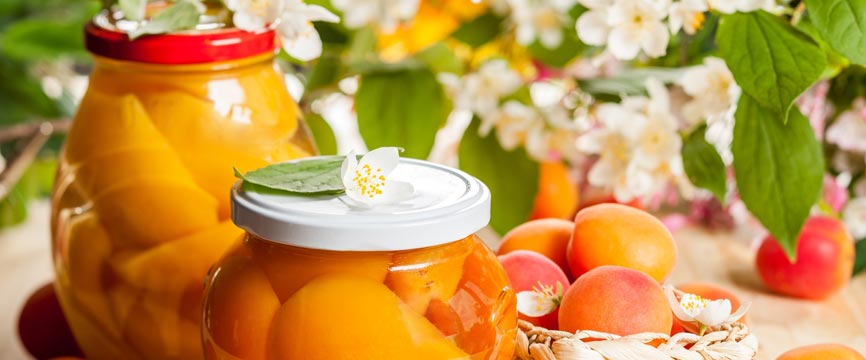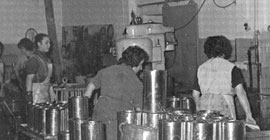
 Degrees Brix in preserved fruit measure its sugar content. Brix is the unit of measure that food industry usually takes for food and beverages such as wine, preserved fruit, juices and soft drinks. But it is also a scale to measure the sugar content of fruits in the market (their degree of ripeness) or even in fresh fruit that has not yet been collected.
Degrees Brix in preserved fruit measure its sugar content. Brix is the unit of measure that food industry usually takes for food and beverages such as wine, preserved fruit, juices and soft drinks. But it is also a scale to measure the sugar content of fruits in the market (their degree of ripeness) or even in fresh fruit that has not yet been collected.
The aim of measuring degrees Brix in preserved fruit and fresh fruit is obviously quite different. In this article, we will focus on the role that sugar content and degrees Brix have in preserved fruit.

What do Brix degrees in preserved fruit indicate?
Brix scale is commonly used for total sugar content measurement for any substance. If a solution has 10 degrees Brix, that means that it contains 10 grams of solid compounds for every 100 grams of solution. Or, in other words, if we are talking about sugar concentration, the content of sugar is 10 grams and the content of water is 90 grams.
Though this unit of measure is usually taken by food industry to fulfil some national and international requirements, final consumers may also find it at the point of sale as an indicator of the level or ripeness of fruits. A fig, a grape or an orange is in its best condition of flavour when it reaches 20 degrees Brix. In the meantime, a strawberry, watermelon and a banana will be at their best, in terms of sweetness, when they reach 16 degrees Brix. It’s curious, isn´t it?
Why is it relevant to know the degrees Brix in preserved fruit?
National and international requirements for food security require a determined content of sugar. The industry of preserved fruit is compelled to measure degrees Brix in order to ensure a determined sugar concentration and, as a result, a correct preservation.
- Fruits in syrup: according to Brix scale, the syrup may be ranked as light syrup (14 to 17 degrees Brix) up to heavy syrup (more than 20 degrees Brix).
- Fruit jam: a minimum of 40 degrees Brix is required.
- Candied fruits: it may vary in a range from 40 to 75 degrees Brix. When Brix is higher than 70, it doesn’t require pasteurization, a compulsory process under that measure. The reason is than pasteurization avoids inhibits microbial growth, extending the life of the product. As an example, non-pasteurized candied fruits last 12 to 24 months, depending on final degrees Brix (65-75); pasteurized candied fruits increase the product lifetime to 3- 5 years depending on the packaging (glass, plastic or can).
How does sugar act as a preservative?
Thus, we already have the key… Accuracy in sugar concentration is important in preserved fruit because sugar itself is the preservative. To be effective in this role, sugar content must be high enough in relation to the final weight of the product. Sugar acts as salt does in food preservation: inhibiting microbial growth after a process of heating at high temperature. (If you are interested in approaching the subject in depth, read about the role of sugar in food preservation in the renowned North American scientific magazine Scientific American).
For non-experts, it is interesting to know the way in which a high sugar concentration inhibits microbial growth in food: actually, sugar kills bacteria and mould letting them die of thirst. That is because water is very good at attracting water in a process called “osmosis”. Thus, the importance of sugar concentration standards for different kinds of preserved fruit.
On the other hand, you would do well to ask yourself why you are warned to refrigerate preserved fruit once the bottle has been opened. The reason is that every tiny drop of water that drips on the surface of fruit jam in an opened bottle (e.g. the condensed water under the lid) might become the ideal breeding ground for mould). It is essential refrigerating fruit jams, jellies and fruits in syrup once the bottle has been unsealed.
How are degrees Brix in preserved fruit measured?
A type of microscope called refractometer is the device used for measuring degrees Brix in preserved fruit. This precision instrument measures the refraction of light in the fruit juice, in such a way that the greater the sugar content, the higher the refraction angle is.
The refractometer was invented by the German physician, optician, entrepreneur and social reformist Karl Abbé, who worked with Carl Zeiss, the famous designer of one of the most valued optics in the world, still used nowadays for microscopes, photographic cameras and so on.
Let us learn something more! Degrees Brix in fresh fruit…
There are different factors that may condition degrees Brix in fresh fruit. They are the following:

- Seeds varieties.
- Testing on fruit trees and time of day.
- Climate (sunlight exposure, temperature and relative humidity).
- Soil and irrigation methods.
- Fertilisers and salinity of irrigation water.
- Harvest timing.
Al those constraints may influx the degrees Brix of fresh fruit, and they take an important role in advancing the Brix scale reached in determined areas when fruit achieves its optimum ripening.
Quality and food safety in Lazaya
Conservas Lazaya has made the commitment to quality of preserved fruit the core of its corporate culture. We grow, process and package fruit from our own plantations in Aragon (Spain). Degrees Brix are in the basis of our daily life: we select the cropping season when fruit is in the optimum level to be processed. Our manufacturing processes fulfil the food quality and safety guidelines based on Hazard Analysis and Critical Control Points (HACCP). We also have prestigious certificates such as ISO 9001, ISO 22000 and IFS. Any preserved fruit made in Lazaya’s facilities has the seal of the best quality.










